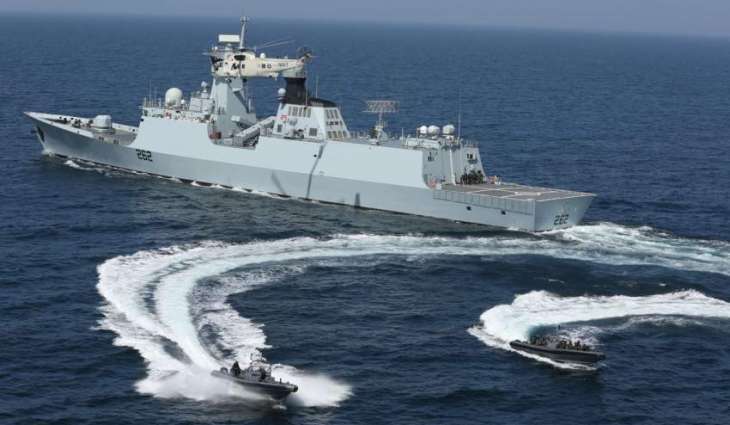Now the journey of AMAN, eighteen years down the lane in the year 2025, has earned a reputation of effective and inclusive collaborative naval exercise which has become more relevant in the backdrop of turmoil in Red Sea and the Middle Eastern crisis
By Tahreem Tariq and Dr. Maliha Zeba Khan
LAHORE: (UrduPoint/Pakistan Point News-Feb 10th, 2025) With an emphasis on promoting peace in the Indian Ocean Region (IOR), Pakistan Navy launched the multinational naval exercise AMAN in 2007.
The purpose of AMAN was to advance collaborative maritime security for a prosperous future by addressing both traditional and non-traditional security challenges of the IOR while promoting security of the IOR through collaborative measures, regional and extra regional cooperation, capacity building, and improving interoperability.
Now the journey of AMAN, eighteen years down the lane in the year 2025, has earned a reputation of effective and inclusive collaborative naval exercise which has become more relevant in the backdrop of turmoil in Red Sea and the middle Eastern crisis.
The IOR experiences a broad spectrum of non-traditional maritime security (NTMS) challenges including piracy, maritime terrorism, and Illegal, Unreported, and Unregulated Fishing (IUUF), resulting in huge economic loss. Natural maritime hazards further exacerbate regional maritime insecurity and potentially affect global flows like food and nutrition, trade, economy and technologies. Smuggling of small arms, narcotics, goods, and individuals has badly impacted the regional and global security order. Against this backdrop, the NTMS challenges require collective action, both from regional and extra-regional actors to foster peace and ensure security of the IOR.
AMAN has forecasted remarkable success to cope with piracy and maritime terrorism. For instance, AMAN 2019 and AMAN 2021 demonstrated a counter-piracy operation including mines sweeping off the coast of Somalia and Gulf of Aden through a simulated scenario and joint-piracy operations respectively. Additionally, AMAN 2021 also anticipated the tracking and interception of suspicious vessels, and deployment of cyber countermeasures to disrupt pirate networks. In the footsteps of previous exercises, AMAN 2023 was itself a notable example of addressing maritime terrorism through a number of activities including a counter-terrorism demonstration by Pakistan Marines. Another positive aspect is holding seminars, conferences and discussions on electronic and print media to highlight the academic perspectives of such exercises.
AMAN has proven to be a victorious initiative in countering NTMS challenges in the IOR. However, it also suffers from a few challenges affecting AMAN's efficacy. These are structural challenges including geopolitical rivalries that exist between many key regional powers, divergent technological capabilities, and strategic competition among actors which hinder active participation in collective maritime security efforts.
Since the Indian Ocean Region is already facing numerous NTMS threats, there can be seen a shift in intensity and nature of these threats, making them more complex with advent of technologies and hands-on expertise of criminal non-state elements like pirates, smugglers, traffickers and other trans-natioal organized criminal groups and mafias. This shift calls for a coordinated approach. In a nutshell, the Indian Ocean Region is at the frontline of numerous NTMS challenges, requiring a collective response. By uniting regional and extra-regional navies with the mutual goal of countering NTMS challenges in the IOR, the AMAN exercise is a groundbreaking initiative by Pakistan that provides a rostrum to participant naval forces to curb these challenges, to ensure a stable and secure IOR for future generations. The long-term efficacy can be achieved through the incorporation of cutting edge maritime technologies, sustained cooperation, and further inclusion of navies and stakeholders having significant interest in the IOR.
The modern technologies such as drones, underwater vehicles, and artificial intelligence could enhance the performance of navies, maritime law enforcement agencies and coast guard for patrolling, detection and surveillance of their maritime zones. These technological advancements could reinforce the capabilities of participating states in addressing NTMS threats through amplifying interoperability, real-time data-sharing, and use of artificial intelligence; the response, detection, and surveillance capabilities of the participating forces in dealing with maritime security can be greatly improved; that is the core purpose of AMAN. Pakistan’s AMAN exercise is not merely an exercise in short, it is the way forward to peace, stability and collaboration for secure seas and oceans beyond Indian Ocean.
The AMAN exercise is a truly noble initiative sung by the participating navies, serving as an international platform for tackling these dangerous NTMS. While Aman can have a secure IOR for the future, it must be through continuous collaboration, technological evolution, and the principle of overcoming geopolitical divergence. By coming together for the shared purpose of combating NTMS.
Authors
Ms. Tahreem Tariq is M. Phil. scholar at the Department of International Relations, National University of Modern Languages (NUML), Islamabad. She is working as the Research Assistant in NUML on a research project of HEC on CPEC and Blue Economy.
Dr. Maliha Zeba Khan is working as an Assistant Professor at the Department of International Relations, National University of Modern Languages (NUML), Islamabad, Pakistan. She is currently working as the Principal Investigator on HEC’s research project on CPEC, non-traditional maritime security linked with fisheries and seafood industry and Blue Economy of Balochistan. She can be contacted at [email protected] and [email protected].




